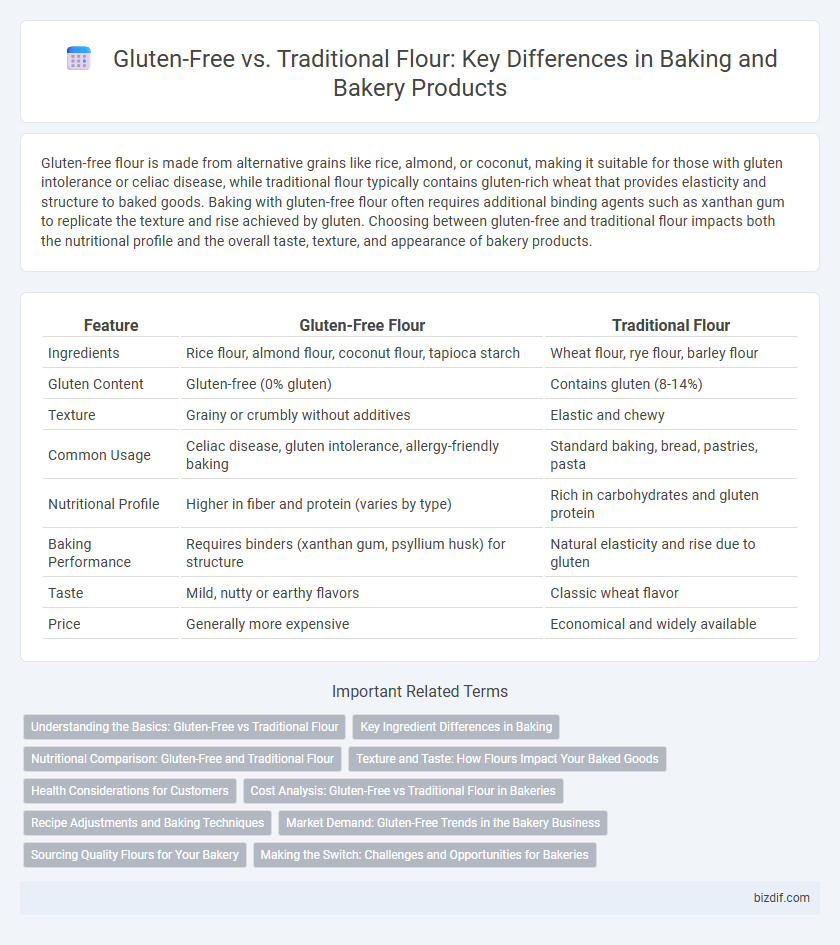Gluten-free flour is made from alternative grains like rice, almond, or coconut, making it suitable for those with gluten intolerance or celiac disease, while traditional flour typically contains gluten-rich wheat that provides elasticity and structure to baked goods. Baking with gluten-free flour often requires additional binding agents such as xanthan gum to replicate the texture and rise achieved by gluten. Choosing between gluten-free and traditional flour impacts both the nutritional profile and the overall taste, texture, and appearance of bakery products.
Table of Comparison
| Feature | Gluten-Free Flour | Traditional Flour |
|---|---|---|
| Ingredients | Rice flour, almond flour, coconut flour, tapioca starch | Wheat flour, rye flour, barley flour |
| Gluten Content | Gluten-free (0% gluten) | Contains gluten (8-14%) |
| Texture | Grainy or crumbly without additives | Elastic and chewy |
| Common Usage | Celiac disease, gluten intolerance, allergy-friendly baking | Standard baking, bread, pastries, pasta |
| Nutritional Profile | Higher in fiber and protein (varies by type) | Rich in carbohydrates and gluten protein |
| Baking Performance | Requires binders (xanthan gum, psyllium husk) for structure | Natural elasticity and rise due to gluten |
| Taste | Mild, nutty or earthy flavors | Classic wheat flavor |
| Price | Generally more expensive | Economical and widely available |
Understanding the Basics: Gluten-Free vs Traditional Flour
Gluten-free flour is made from alternative grains like rice, almond, or coconut, which lack the gluten protein found in traditional wheat flour essential for dough elasticity and structure. Traditional flour contains gluten, a network-forming protein crucial for trapping gas during fermentation, resulting in the chewy texture of baked goods. Understanding these fundamental differences is key for bakers aiming to achieve desired textures and flavors in gluten-free versus traditional recipes.
Key Ingredient Differences in Baking
Gluten-free flour lacks the gluten protein found in traditional wheat flour, which provides elasticity and structure to baked goods. Common gluten-free alternatives include almond flour, rice flour, and tapioca starch, each contributing unique textures and moisture levels. Bakers often combine these flours with binding agents like xanthan gum or guar gum to replicate the properties of gluten in recipes.
Nutritional Comparison: Gluten-Free and Traditional Flour
Gluten-free flours such as almond, rice, and coconut typically offer higher protein and fiber content compared to traditional wheat flour, which is rich in gluten and carbohydrates. Traditional wheat flour provides essential B vitamins and minerals like iron and magnesium that are often lower or absent in gluten-free alternatives. Consumers seeking gluten-free options should consider fortified flours to bridge nutritional gaps and maintain a balanced diet.
Texture and Taste: How Flours Impact Your Baked Goods
Gluten-free flour often produces denser, crumblier baked goods due to the absence of gluten, which provides elasticity and structure in traditional flour. Traditional wheat flour offers a chewy texture and richer taste, creating classic bakery items with a tender crumb and pronounced flavor. Selecting the right flour impacts moisture retention, rise, and mouthfeel, making it crucial for achieving desired bakery quality in gluten-free versus conventional recipes.
Health Considerations for Customers
Gluten-free flour is essential for customers with celiac disease or gluten intolerance, as it helps prevent adverse reactions and promotes digestive health. Traditional flour contains gluten, which can trigger inflammation and gastrointestinal issues in sensitive individuals but provides better texture and structure in baked goods. Choosing the right flour depends on individual health needs, with gluten-free options supporting dietary restrictions and traditional flour offering better baking performance for those without sensitivities.
Cost Analysis: Gluten-Free vs Traditional Flour in Bakeries
Gluten-free flour typically costs two to three times more than traditional wheat flour due to specialized sourcing and processing requirements. Bakeries using gluten-free flour must consider higher ingredient expenses that impact overall product pricing and profit margins. Despite the increased cost, the growing demand for gluten-free products can justify the investment through access to a niche market segment.
Recipe Adjustments and Baking Techniques
Gluten-free baking requires careful adjustments such as incorporating xanthan gum or guar gum to mimic gluten's elasticity, which is absent in traditional flour recipes. Precise measurements of alternative flours like rice, almond, or coconut flour are essential to maintain moisture and texture in gluten-free products. Techniques like reducing mixing time and increasing baking powder help achieve the desired rise and crumb structure unique to gluten-free baked goods.
Market Demand: Gluten-Free Trends in the Bakery Business
The bakery industry has seen a significant surge in market demand for gluten-free products, driven by increased consumer awareness of gluten intolerance and celiac disease. Gluten-free flour blends, often composed of rice, almond, and tapioca flours, are gaining popularity as they cater to health-conscious customers seeking alternatives to traditional wheat-based flours. This trend is reshaping product lines, motivating bakeries to innovate while balancing texture and flavor to meet evolving consumer preferences.
Sourcing Quality Flours for Your Bakery
Sourcing quality flours is essential for bakery success, with gluten-free flours such as almond, rice, and sorghum offering distinct nutritional profiles and baking properties compared to traditional wheat-based flours. Prioritizing suppliers that provide organic, non-GMO certifications and consistent milling processes ensures superior texture and flavor in gluten-free products. Understanding the specific protein content and starch quality in both gluten-free and traditional flours enables bakers to optimize recipes for product consistency and customer satisfaction.
Making the Switch: Challenges and Opportunities for Bakeries
Switching from traditional flour to gluten-free alternatives poses challenges such as adjusting recipes to maintain texture and flavor while accommodating different ingredient properties. Bakeries need to invest in specialized equipment and training to avoid cross-contamination and ensure product safety for gluten-sensitive customers. This transition offers opportunities to tap into the growing gluten-free market, attracting health-conscious consumers and expanding product diversity.
Gluten-Free vs Traditional Flour Infographic

 bizdif.com
bizdif.com